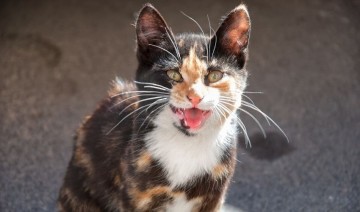Cats are known for their stealthy hunting abilities and soft paws for quiet approaches, but some cats have incredibly powerful voices and are far from silent. Understanding why cats meow and how much meowing may be too much can help cat owners be aware of their feline friend’s communication and what it really means.
Why Cats Meow
Cats meow to communicate with humans, because we react to their meows and they quickly learn to meow, purr, yowl, mew, and howl to let us know exactly what they want. A cat’s meow can communicate many things, including…
- Greetings – A cat will often meow just to say hello, especially if you’ve been away for any length of time or if the cat has been alone.
- Needing Attention – Cats might ask for food, demand playtime, request belly rubs, or demand attention with firm meows. An anxious cat may also meow more in an attempt to get noticed.
- Emotions – Different types of meows and yowls can show a cat’s emotions, from fear and anxiety to friendliness and appreciation.
- Warnings – A stronger, louder, more strident meow can be a warning, either if the cat is showing dominance to warn away a competitor or warning its human of a potential threat.
- Confusion – If a cat is confused or disoriented, a tentative meow or more imploring yowl may be a cry for help, especially if the cat feels lost or trapped.
- Sexual Attraction – A female cat in heat may meow or yowl as her hormones fluctuate and she seeks a mate, and a male cat may meow in the same way if he smells a female nearby.
- Reactions – A cat may meow as a response to our own actions, especially if the cat recognizes what we are doing and wants to emphasize that action, such as filling a food bowl.
- Illness or Injury – A cat that is hurt or ill may meow, howl, yowl, spit, or screech in response to pain or discomfort. These meows are often much louder and more insistent than other sounds.
As you gain familiarity with your cat’s voice and vocalizations, you will begin to recognize what different types of meows may mean, and you will be able to respond appropriately to your cat’s communication.
How Much Meowing Is Too Much?
All cats meow to some extent, though the amount of meowing will depend on the cat’s overall personality and if their vocalizing accomplishes what they want (getting food, for example). Some cat breeds are especially known for louder, more insistent, more frequent meowing, including…
- American bobtail
- Bengal
- Siamese
- Sphynx
- Turkish van
Younger cats will often meow more than adults, though senior cats may also start to vocalize more, especially if they have more physical complaints or feel confused more often.
If the meowing gets to be too loud or too insistent for you, your family, or your neighbors, it is time to take steps to curb your cat’s communication. Furthermore, if your cat’s meowing suddenly changes or you notice any other signs of distress associated with different meows, it is important to consult a veterinarian right away in case more serious issues may be causing your cat’s meowing.
Quieting Your Vocal Cat
When your cat may be meowing too much, it is important to find the cause of the meowing in order to encourage quiet. This is especially critical if the cat could be sick, injured, or in distress. Correcting other issues, such as hunger, can also help quiet your cat. When you are trying to keep your cat from excessive meowing and yowling, consider…
- Spaying or neutering an intact cat to minimize the hormone fluctuations from heat cycles and mating urges that can cause more meowing.
- Installing a cat door or providing more litter boxes if the cat is meowing to go outside for potty business, so the cat can meet its own needs without your assistance.
- Avoiding rewarding excessive meows with treats or more food, and instead stick to mealtimes so the cat will learn that begging behavior is not successful.
- Hiring a pet sitter or using entertainment such as a bird feeder or cat-friendly videos to calm an anxious cat when you may be away and the cat needs companionship.
- Reducing the cat’s anxiety by returning to a familiar routine, regular food options, litter box placement, and other daily features that can calm a cat that doesn’t like change.
If you can’t find the cause of your cat’s excessive meowing, consult your veterinarian in case health conditions or other factors may be the problem. It is important never to ignore your cat’s communication, but also do not resort to negative punishments that will only instill fear in your pet and increase the cat’s anxiety.
A cat’s meowing is its communication, and a meowing cat is always trying to tell its owner something. Once you understand what different meows and yowls may mean, you can better meet your cat’s needs and share happy, healthy communication between you both.






Comments